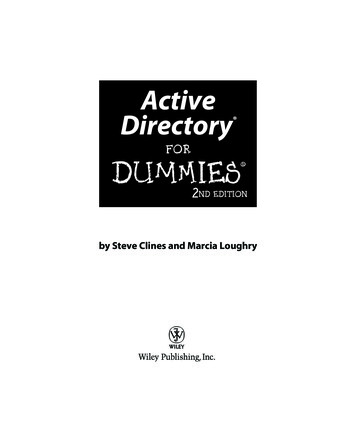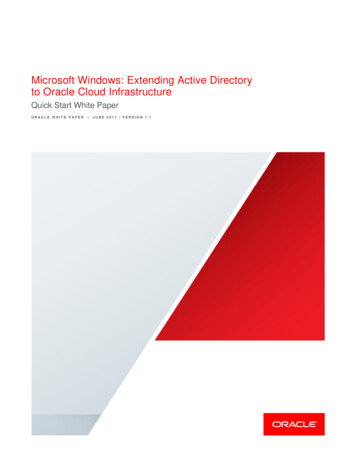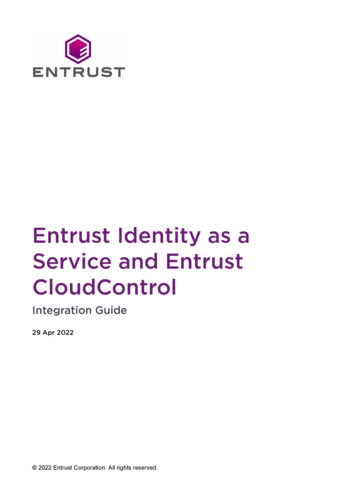
Transcription
Continue
Active directory cookbook pdfThe Active Directory Cookbook, 4th Edition is a handy reference book to have if you manage any part of Active Directory. The latest edition by authors Brian Svidergol and Robbie Allen, has been updated to include recipes for Windows 2012 and Windows 8. The book is written in a style that makes iteasy to find solutions for actions performed in Active Directory. The format of problem-solution-discussion provides a way to quickly find what you need, perform the action and move on to the next thing. There are always many ways to accomplish things in a Microsoft environment. This book recognizesthat and provides multiple ways of getting things done Prefer the GUI? Prefer PowerShell? The cookbook has you covered. I found this book very helpful when implementing AD FS and AD LDS–two fairly uncommon segments of Active Directory. I would definitely recommend having this book in yourarsenal. Tim Golden Python Stuff Active Directory Active Directory Cookbook Introduction These examples assume you are using the active directory module from this site. The following are examples of useful things that could be done with this module on win32 machines. The following examples,except where stated otherwise, all assume that you are connecting to the default Active Directory (the one you're logged in to). Note also that the examples are designed to be complete and can be cut-and-pasted straight into a .py file, or even onto an open Python interpreter window (at least runningunder CMD on Win2000; that's how I test them). Just select the code, including the final blank line, right-click [Copy], select your Python interpreter window, and right-click. Examples Find a user (quick method) This example uses a module-level function which assumes that you're interested in the currentactive directory and want to match either the account name or the full name. import active directory user active directory.find user ("goldent") print user Find a computer (quick method) This example uses a module-level function which assumes that you're interested in the current active directory.import active directory computer active directory.find computer ("vogbp200") print computer List all users import active directory for user in active directory.search ("objectCategory 'Person'", "objectClass 'User'"): print user # # or # for user in active directory.search (objectCategory 'Person',objectClass 'User'): print user List users in an OU To narrow a search down to something less that the whole active directory, call the search method on a particular AD node. You can either instantiate one directly (as in this example) or you can walk down the tree to find the one you want. importactive directory users active directory.AD object ("LDAP://ou Users,dc com,dc example") for user in users.search (objectCategory 'Person'): print user List all groups import active directory for group in active directory.search (objectClass 'group'): print group.cn Show the members of a groupimport active directory me active directory.find user () # defaults to current user for group in me.memberOf: print "Members of group", group.cn for group member in group.member: print " ", group member Show all the members of a group, recursively import active directory domain admins active directory.find group ("Domain Admins") all users set () for group, groups, users in domain admins.walk (): all users.update (users) # # or, if you want to get functional: # # all users reduce (set.union, (users for group, groups, users in domain admins.walk ()), set ()) # for user in all users: printuser Show the types of a group import active directory me active directory.find user () for group in me.memberOf: print "Group types for", group.cn, ":", ", ".join (group.groupType) List the groups a user is in import active directory user active directory.find user () print "User:", user.cn for group inuser.memberOf: print " ", group List domain controllers for the active domain import active directory for master in active directory.root ().masteredBy: print master.Parent.dNSHostName Информация Дискусия (0) Files Holdings Table of contents : CoverTitle PageCopyright and CreditsAboutPacktContributorsTable of ContentsPrefaceChapter 1: Optimizing Forests, Domains, and Trusts Choosing between a new domain or forest Why would you have a new domain? What are the downsides of a new domain? Why would you create a new forest? What are the downsides of a new forest?Listing the domains in your forest Getting ready Installing the Active Directory module for Windows PowerShell on Windows Server Installing the Active Directory module for Windows PowerShell on Windows Required permissions How to do it. How it works. Using adprep.exe to prepare for new ActiveDirectory functionality Getting ready Required permissions How to do it. Preparing the forest Preparing the forest for RODCs Preparing the domain Fixing up Group Policy permissions Checking the preparation replication How it works. There's more. Raising the domain functional level to WindowsServer 2016 Getting ready Required permissions How to do it. How it works. Raising the forest functional level to Windows Server 2016 Getting ready Required permissions How to do it. How it works. Creating the right trust Trust direction Trust transitivity One-way or two-way trust Getting readyRequired permissions How to do it. Verifying and resetting a trust Getting ready Required permissions How to do it. How it works. Securing a trust Getting ready Required permissions How to do it. How it works. There's more. Extending the schema Getting ready Required permissions How to doit. There's more. Enabling the Active Directory Recycle Bin Getting ready Required permissions How to do it. How it works. Managing UPN suffixes Getting ready How to do it. How it works. There's more.Chapter 2: Managing Domain Controllers Preparing a Windows Server to become a domaincontroller Intending to do the right thing Dimensioning the servers properly Preparing the Windows Server installations Preconfigure the Windows Servers Document the passwords Promoting a server to a domain controller Getting ready How to do it. Promoting a domain controller using the wizardInstalling the Active Directory Domain Services role Promoting the server to a domain controller Promoting a domain controller using dcpromo.exe Promoting a domain controller using Windows PowerShell Checking proper promotion See also Promoting a server to a read-only domain controller Gettingready How to do it. Installing the Active Directory Domain Services role Promoting the server to a read-only domain controller Promoting a read-only domain controller using dcpromo.exe Promoting a domain controller using Windows PowerShell Checking proper promotion How it works. See alsoUsing Install From Media How to do it. Creating the IFM package Leveraging the IFM package Using the Active Directory Domain Services Configuration Wizard Using dcpromo.exe Using the Install-ADDSDomainController PowerShell cmdlet How it works. Using domain controller cloning Getting readyHow to do it. Making sure all agents and software packages are cloneable Supplying the information for the new domain controller configuration Adding the domain controller to the Cloneable Domain Controllers group Cloning the domain controller from the hypervisor How it works. See alsoDetermining whether a virtual domain controller has a VM-GenerationID How to do it. How it works. Demoting a domain controller Getting ready How to do it. Using the wizard Using the Active Directory module for Windows PowerShell How it works. There's more. Demoting a domain controllerforcefully How to do it. Using the Active Directory Domain Services Configuration Wizard Using manual steps Performing metadata cleanup Deleting the domain controller from DNS Deleting the computer object for the domain controller Deleting the SYSVOL replication membership Deleting the domaincontroller from Active Directory Sites and Services Deleting an orphaned domain See also Inventory domain controllers How to do it. Using Active Directory Users and Computers to inventory domain controllers Using the Active Directory module for Windows PowerShell to inventory domain controllersDecommissioning a compromised read-only domain controller How to do it. How it works.Chapter 3: Managing Active Directory Roles and Features About FSMO roles Recommended practices for FSMO roles Querying FSMO role placement Getting ready How to do it. How it works. TransferringFSMO roles Getting ready How to do it. Transferring FSMO roles using the MMC snap-ins Transferring FSMO roles using the ntdsutil command-line tool Transferring FSMO roles using Windows PowerShell How it works. Seizing FSMO roles Getting ready How to do it. Seizing FSMO roles using thentdsutil command-line tool Seizing FSMO roles using Windows PowerShell How it works. Configuring the Primary Domain Controller emulator to synchronize time with a reliable source Getting ready How to do it. How it works. Managing time synchronization for virtual domain controllers Getting readyHow to do it. Managing time synchronization for virtual domain controllers running on VMware vSphere Managing time synchronization for virtual domain controllers running on Microsoft Hyper-V How it works. Managing global catalogs Getting ready How to do it. How it worksChapter 4: ManagingContainers and Organizational Units Differences between OUs and containers Containers OUs OUs versus Active Directory domains Creating an OU Getting ready How to do it. Using the Active Directory Administrative Center Using the command line Using Windows PowerShell How it works. There'smore. Deleting an OU Getting ready How to do it. Using the Active Directory Administrative Center Using the command line Using Windows PowerShell How it works. There's more. Modifying an OU Getting ready How to do it. Using the Active Directory Administrative Center Using the commandline Using Windows PowerShell How it works. There's more. See also Delegating control of an OU Getting ready How to do it. Using Active Directory Users and Computers Using the command line How it works. Using the built-in groups Using delegation of control See also Modifying the defaultlocation for new user and computer objects Getting ready How to do it. How it works. See alsoChapter 5: Managing Active Directory Sites and Troubleshooting Replication What do Active Directory sites do? Recommendations Creating a site Getting ready How to do it. Using Active Directory Sitesand Services Using Windows PowerShell See also Managing a site Getting ready How to do it. Using Active Directory Sites and Services Using Windows PowerShell How it works. See also Managing subnets Getting ready How to do it. Using Active Directory Sites and Services Using WindowsPowerShell How it works. See also Creating a site link Getting ready How to do it. Using Active Directory Sites and Services Using Windows PowerShell How it works. See also Managing a site link Getting ready How to do it. Using Active Directory Sites and Services Using Windows PowerShellSee also Modifying replication settings for an Active Directory site link Getting ready How to do it. Using Active Directory Sites and Services Using Windows PowerShell How it works. Site-link costs Site-link replication schedules See also Creating a site link bridge Getting ready How to do it. See alsoManaging bridgehead servers Getting ready How to do it. Using Active Directory Sites and Services Using Windows PowerShell How it works. See also Managing the Inter-site Topology Generation and Knowledge Consistency Checker Getting ready How to do it. Using Active Directory Sites andServices Using Windows PowerShell How it works. See also Managing universal group membership caching Getting ready How to do it. Using Active Directory Sites and Services Using Windows PowerShell How it works. See also Working with repadmin.exe Getting ready How to do it. How itworks. See also Forcing replication Getting ready How to do it. How it works. See also Managing inbound and outbound replication Getting ready How to do it. How it works. There's more. See also Modifying the tombstone lifetime period Getting ready How to do it. Using ADSI Edit UsingWindows PowerShell How it works. See also Managing strict replication consistency Getting ready How to do it. How it works. Upgrading SYSVOL replication from File Replication Service to Distributed File System Replication Getting ready How to do it. The initial state The prepared state Theredirected state The eliminated state How it works. See also Checking for and remediating lingering objects Getting ready How to do it. How it works. See alsoChapter 6: Managing Active Directory Users Creating a user Getting ready How to do it. Using Active Directory Users and Computers Usingthe Active Directory Administrative Center Using command-line tools Using Windows PowerShell How it works. There's more. Deleting a user Getting ready How to do it. Using Active Directory Users and Computers Using the Active Directory Administrative Center Using command-line tools UsingWindows PowerShell How it works. See also Modifying several users at once Getting ready How to do it. Using Active Directory Users and Computers Using the Active Directory Administrative Center Using Windows PowerShell How it works. There's more. Moving a user Getting ready How to doit. Using Active Directory Users and Computers Using the Active Directory Administrative Center Using command-line tools Using Windows PowerShell How it works. Renaming a user Getting ready How to do it. Using Active Directory Users and Computers Using the Active Directory AdministrativeCenter Using command-line tools Using Windows PowerShell How it works. Enabling and disabling a user Getting ready How to do it. Using Active Directory Users and Computers Using the Active Directory Administrative Center Using command-line tools Using Windows PowerShell How it works.There's more. Finding locked-out users Getting ready How to do it. Using the Active Directory Administrative Center Using Windows PowerShell How it works. See also Unlocking a user Getting ready How to do it. Using the Active Directory Administrative Center Using Windows PowerShellManaging userAccountControl Getting ready How to do it. Reading the userAccountControl attribute Using Active Directory Users and Computers Using the Active Directory Administrative Center Using Windows PowerShell Setting the userAccountControl attribute Using ADSI Edit Using WindowsPowerShell How it works. Using account expiration Getting ready How to do it. Using Active Directory Users and Computers Using the Active Directory Administrative Center Using command-line tools Using Windows PowerShell How it works.Chapter 7: Managing Active Directory Groups Creating agroup Getting ready How to do it. Using Active Directory Users and Computers Using the Active Directory Administrative Center Using command-line tools Using Windows PowerShell How it works. Group scopes Group types Deleting a group Getting ready How to do it. Using Active Directory Groupsand Computers Using the Active Directory Administrative Center Using command-line tools Using Windows PowerShell How it works. Managing the direct members of a group Getting ready How to do it. Using Active Directory Groups and Computers Using the Active Directory Administrative CenterUsing Windows PowerShell How it works. Managing expiring group memberships Getting ready How to do it. How it works. Changing the scope or type of a group Getting ready How to do it. Using Active Directory Groups and Computers Using the Active Directory Administrative Center Usingcommand-line tools Using Windows PowerShell How it works. Group scopes Group types Viewing nested group memberships Getting ready How to do it. How it works. Finding empty groups Getting ready How to do it. How it works.Chapter 8: Managing Active Directory Computers Creating acomputer Getting ready How to do it. Using Active Directory Users and Computers Using the Active Directory Administrative Center Using command-line tools Using Windows PowerShell How it works. There's more. Deleting a computer Getting ready How to do it. Using Active Directory Users andComputers Using the Active Directory Administrative Center Using command-line tools Using Windows PowerShell How it works. See also Joining a computer to the domain Getting ready How to do it. Using the GUI Using Windows PowerShell How it works. There's more. See also Renaming acomputer Getting ready How to do it. Using the settings app Using the command line Using Windows PowerShell How it works. There's more. Testing the secure channel for a computer Getting ready How to do it. Using the command line Using Windows PowerShell How it works. See alsoResetting a computer's secure channel Getting ready How to do it. Using Active Directory Users and Computers Using the Active Directory Administrative Center Using the command line Using Windows PowerShell How it works. Changing the default quota for creating computer objects Getting readyHow to do it. Using ADSI Edit Using Windows PowerShell How it works.Chapter 9: Getting the Most Out of Group Policy Creating a Group Policy Object (GPO) Getting ready How to do it. Using the Group Policy Management Console Using Windows PowerShell How it works. See also Copying aGPO Getting ready How to do it. Using the Group Policy Management Console Using Windows PowerShell How it works. There's more. Deleting a GPO Getting ready How to do it. Using the Group Policy Management Console Using Windows PowerShell How it works. See also Modifying thesettings of a GPO Getting ready How to do it. How it works. Assigning scripts Getting ready How to do it. How it works. Installing applications Getting ready How to do it. How it works. Linking a GPO to an OU Getting ready How to do it. How it works. There's more. Blocking inheritance ofGPOs on an OU Getting ready How to do it. How it works. Enforcing the settings of a GPO Link Getting ready How to do it. How it works. Applying security filters Getting ready How to do it. How it works. Creating and applying WMI Filters Getting ready How to do it. How it works. There's more.Configuring loopback processing Getting ready How to do it. How it works. Restoring a default GPO Getting ready How to do it. How it works. There's more. Creating the Group Policy Central Store Getting ready How to do it. How it works. There's more.Chapter 10: Securing Active DirectoryApplying fine-grained password and account lockout policies Getting ready How to do it. Using the Active Directory Administrative Center Using the Active Directory Module for Windows PowerShell How it works. There's more. Backing up and restoring GPOs Getting ready How to do it. How itworks. There's more. Backing up and restoring Active Directory Getting ready How to do it. How it works. Working with Active Directory snapshots Getting ready How to do it. How it works. There's more. Managing the DSRM passwords on domain controllers Getting ready How to do it. How itworks. Implementing LAPS Getting ready How to do it. Implementing LAPS Extending the schema Setting permissions Creating the GPO to install the LAPS Client-side Extensions Linking the GPO to OUs with devices Managing passwords Viewing an administrator password Resetting an Administratorpassword How it works. See also Managing deleted objects Getting ready How to do it. Using the Active Directory Administrative Center Using Windows PowerShell How it works. There's more. See also Working with group Managed Service Accounts Getting ready How to do it. How it works.There's more. Configuring the advanced security audit policy Getting ready How to do it. How it works. Resetting the KRBTGT secret Getting ready How to do it. How it works. There's more. Using SCW to secure domain controllers Getting ready How to do it Secure a representative domaincontroller using SCW Roll-out the security settings to all domain controllers using Group Policy How it works. Leveraging the Protected Users group Getting ready How to do it. Using Active Directory Users and Computers Using the Active Directory Administrative Center Using Windows PowerShellHow it works. Putting authentication policies and authentication policy silos to good use Getting ready How to do it. Enable domain controller support for claims Enable compound claims on devices in scope for an authentication policy Create an Authentication Policy Create an Authentication Policy SiloAssign the Authentication Policy Silo How it works. Configuring Extranet Smart Lock-out Getting ready How to do it. How it works.Chapter 11: Managing Federation Choosing the right AD FS farm deployment method Getting ready How to do it. How it works. There's more. See also Installing theAD FS server role Getting ready How to do it. How it works. Setting up an AD FS farm with Windows Internal Database Getting ready How to do it. Configuring AD FS Checking the proper AD FS configuration How it works. There's more. See also Setting up an AD FS farm with SQL Server Gettingready How to do it. Creating a gMSA Creating the script Creating the databases Configuring AD FS Checking the proper AD FS configuration How it works. There's more. See also Adding additional AD FS servers to an AD FS farm Getting ready How to do it. How it works. See also Removing ADFS servers from an AD FS farm Getting ready How to do it. How it works. There's more. Creating a Relying Party Trust (RPT) Getting ready How to do it. How it works. Deleting an RPT Getting ready How to do it. How it works. Configuring branding Getting ready How to do it. How it works.Setting up a Web Application Proxy Getting ready How to do it. Installing the Web Application Proxy feature Configuring the Web Application Proxy Checking the proper Web Application Proxy configuration How it works. There's more. Decommissioning a Web Application Proxy Getting ready How todo it. How it works.Chapter 12: Handling Authentication in a Hybrid World (AD FS, PHS, PTA, and 3SO) Choosing the right authentication method Getting ready How to do it. How it works. Active Directory Federation Services or PingFederate Password Hash Sync Pass-through authenticationSeamless Single Sign-on Cloud-only There's more. Verifying your DNS domain name Getting ready How to do it. How it works. Implementing Password Hash Sync with Express Settings Getting ready How to do it. How it works. Implementing Pass-through Authentication Getting ready How to doit. Adding the Azure AD Authentication Service to the intranet sites Configuring Azure AD Connect How it works. There's more. Implementing single sign-on to Office 365 using AD FS Getting ready How to do it. How it works. There's more. Managing AD FS with Azure AD Connect Getting readyHow to do it. Reset Azure AD trust Federate an Azure AD domain Update the AD FS SSL certificate Deploy an AD FS server Add a Web Application Proxy server Verify federated login How it works. There's more. Implementing Azure Traffic Manager for AD FS geo-redundancy Getting ready How todo it. Configuring the Web Application Proxies for probing Configuring Azure Traffic Manager Adding DNS records How it works. There's more. Migrating from AD FS to Pass-through Authentication for single sign-on to Office 365 Getting ready How to do it. Adding the Azure AD AuthenticationService to the intranet sites Configuring Azure AD Connect Checking domains in the Azure portal Disabling federation in Azure AD Deleting the Office 365 Identity Platform relying party trust How it works. There's more. Making Pass-through Authentication (geo)redundant Getting ready How to do it.Installing and configuring the PTA Agent Checking proper installation and configuration How it works.Chapter 13: Handling Synchronization in a Hybrid World (Azure AD Connect) Choosing the right sourceAnchor Getting ready How to do it. How it works. There's more. Configuring staging modeGetting ready How to do it. How it works. See also Switching to a staging mode server Getting ready How to do it. How it works. Configuring Domain and OU filtering Getting ready How to do it. Configuring Azure AD Connect initially Reconfiguring Azure AD Connect How it works. ConfiguringAzure AD app and attribute filtering Getting ready How to do it. Configuring Azure AD Connect initially Reconfiguring Azure AD Connect How it works. Configuring MinSync Getting ready How to do it. Configuring Azure AD Connect initially Reconfiguring Azure AD Connect How it works. ConfiguringHybrid Azure AD Join Getting ready How to do it. Adding the Azure AD Device Registration Service to the intranet sites Distributing Workplace Join for non-Windows 10 computers Setting the Group Policy to register for down-level Windows devices Link the Group Policy to the right Organizational UnitsConfiguring Hybrid Azure AD Join in Azure AD Connect How it works. Configuring Device writeback Getting ready How to do it. How it works. Configuring Password writeback Getting ready How to do it. Configuring the proper permissions for Azure AD Connect service accounts Configuring AzureAD Connect Configuring Azure AD Connect initially Reconfiguring Azure AD Connect How it works. Configuring Group writeback Getting ready How to do it. Creating the Organizational Unit where groups are to be written back Configuring Azure AD Connect Configuring Azure AD Connect initiallyReconfiguring Azure AD Connect Configuring the proper permissions for Azure AD Connect service accounts How it works. Changing the passwords for Azure AD Connects service accounts Getting ready How to do it. Managing the service account connecting to Active Directory Managing the serviceaccount connecting to Azure AD Managing the computer account for Seamless Single Sign-on How it works. The service account running the Azure AD Connect service The service account connecting to Active Directory The service account connecting to Azure AD The computer account for SeamlessSingle Sign-onChapter 14: Hardening Azure AD Setting the contact information Getting ready How to do it. How it works. Preventing non-privileged users from accessing the Azure portal Getting ready How to do it. How it works. Viewing all privileged users in Azure AD Getting ready How to do it.Using the Azure AD PowerShell Using the Azure Cloud Shell How it works. Preventing users from registering or consenting to apps Getting ready How to do it. How it works. There's more. Preventing users from inviting guests Getting ready How to do it. How it works. There's more. See alsoConfiguring whitelisting or blacklisting for Azure AD B2B Getting ready How to do it. How it works. Configuring Azure AD Join and Azure AD Registration Getting ready How to do it. Limiting who can join Azure AD devices Limiting who can register Azure AD devices Configuring additionaladministrators Enabling Enterprise State Roaming How it works. See also Configuring Intune auto-enrollment upon Azure AD Join Getting ready How to do it. How it works. Configuring baseline policies Getting ready How to do it. How it works. Configuring Conditional Access Getting ready How todo it. How it works. See also Accessing Azure AD Connect Health Getting ready How to do it. How it works. There's more. Configuring Azure AD Connect Health for AD FS Getting ready How to do it. Downloading the agent Installing and configuring the agent Consuming the information in theAzure AD Connect Health dashboard How it works. Configuring Azure AD Connect Health for AD DS Getting ready How to do it. Downloading the agent Installing and configuring the agent Consuming the information in the Azure AD Connect Health dashboard How it works. Configuring Azure ADPrivileged Identity Management Getting ready How to do it. How it works. There's more. Configuring Azure AD Identity Protection Getting ready How to do it. How it works. MFA registration User risk policies Sign-in risk policies There's more.Other Books You May EnjoyIndex Citation previewActive Directory Administration Cookbook Actionable, proven solutions to identity management and authentication on servers and in the cloud Sander Berkouwer BIRMINGHAM - MUMBAI Active Directory Administration Cookbook Copyright 2019 Packt Publishing All rights reserved. No part of thisbook may be reproduced, stored in a retrieval system, or transmitted in any form or by any means, without the prior written permission of the publisher, except in the case of brief quotations embedded in critical articles or reviews. Every effort has been made in the preparation of this book to ensure theaccuracy of the information presented. However, the information contained in this book is sold without warranty, either express or implied. Neither the author, nor Packt Publishing or its dealers and distributors, will be held liable for any damages caused or alleged to have been caused directly or indirectlyby this book. Packt Publishing has endeavored to provide trademark information about all of the companies and products mentioned in this book by the appropriate use of capitals. However, Packt Publishing cannot guarantee the accuracy of this information. Commissioning Editor: Pavan RamchandaniAcquisition Editor: Rohit Rajkumar Content Development Editor: Aishwarya Moray Technical Editor: Rutuja Patade
Active directory cookbook pdf The Active Directory Cookbook, 4th Edition is a handy reference book to have if you manage any part of Active Directory. The latest edition by authors Brian Svidergol and Robbie Allen, has been updated to include recipes for Windows 2012 and Windows 8. The book is written in a style that makes it


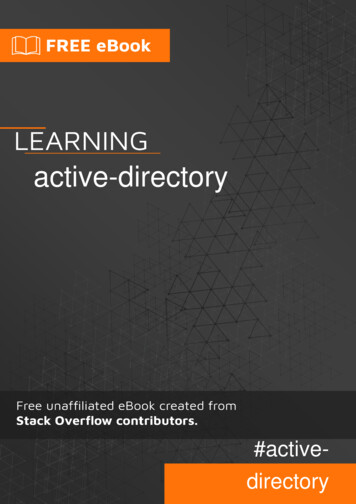
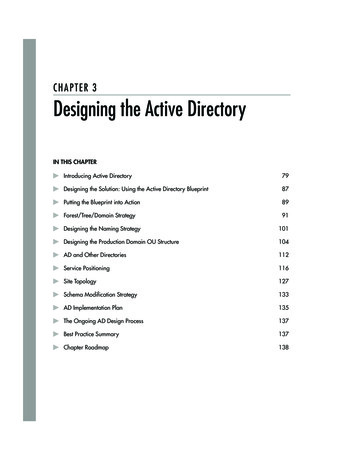
![[MS-ADFSOD]: Active Directory Federation Services (AD FS .](/img/1/5bms-adfsod-5d.jpg)


